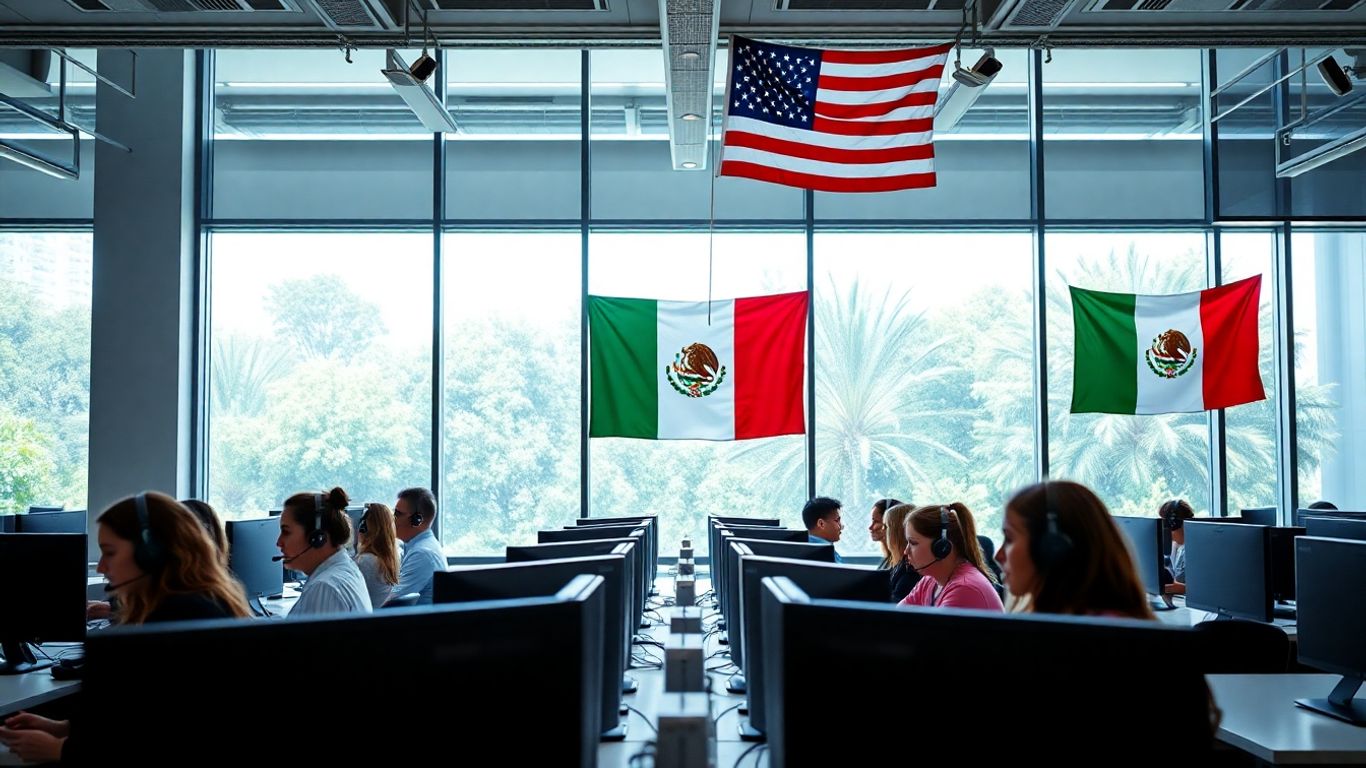When you run a business in the US, finding ways to save money and work smarter is always on your mind. That’s why more companies are turning to a Mexico call center in 2025. It’s not just about cutting costs—there’s a lot more to it. You get people who speak both English and Spanish, work in your time zone, and know how US businesses tick. Plus, you’re not dealing with the headaches that come from working with teams halfway across the world. If you’re considering outsourcing your customer calls, here’s why picking a Mexico call center might just be the move that makes everything click.
Choosing a call center in Mexico has become a go-to move for U.S. companies in 2025, and not just for cost reasons. The true edge lies in how well Mexico fits with U.S. business needs, breaking the old cycle of unpredictable offshore setbacks. Below, we break down the real reasons companies keep shifting south of the border.
When everyone’s on the same clock, you can actually get things done right when you need them—not after your customer’s gone to bed frustrated.
Table: Typical Direct Flight Times (Hours)
Short travel times make it easy for U.S. managers to build trust and keep oversight tight—something tough to do with teams way offshore.
If you’re planning to grow your business, picking a Mexico call center means you don’t have to teach your team brand-new habits or communication styles. Integration comes pretty naturally, saving time and hassle from day one.
For many US businesses wondering where to find major savings without cutting corners, Mexico call centers are the obvious answer. Partnering with Mexican providers brings real, measurable reductions in key cost areas—without the hidden drawbacks you might expect from traditional offshore options. Let’s get into how this can actually impact your bottom line.
Let’s face it: saving more than half on labor is a game-changer for small and mid-sized US businesses.
Knowing your exact customer support spend each month lets you plan, budget, and shift resources where they’re most needed—without surprises.
Top ways Mexico call centers trim your overhead:
So, for 2025 and beyond, the question isn’t whether outsourcing to Mexico saves money; it’s how much more competitive your business will become when it does.
Mexico is quickly becoming the go-to place for businesses in the U.S. that need expert customer support—in both English and Spanish. More and more companies realize there’s a unique advantage in working with Mexican call centers, not just because of lower costs or closer time zones, but because of the talent itself.
Mexican agents are known for clear and confident English, which means customer conversations don’t feel forced or awkward. Many have years of experience handling complex inquiries for American companies. When your customers call, they get a professional on the line—someone who gets their questions, idioms, and even small talk.
A 2025 sample language proficiency rating table shows how agents at Mexican call centers stack up:
Customers feel more comfortable (and stick around longer) when agents sound relatable and respond quickly.
When you have bilingual agents, you don’t just reach the U.S.—you get access to the entire Spanish-speaking world, which is massive. U.S. businesses can:
This isn’t just a perk; it’s a game-changer for brands trying to grow in the Americas. With so much consumer power in Spanish-speaking markets, being able to support both languages out of one team is a smart shortcut.
Staying sharp is part of the culture in Mexico’s top call centers. There’s always new technology, new policies, and higher expectations from clients. Agents don’t just go through onboarding—they’re constantly learning and upskilling, often taking advantage of powerful online CRM and analytics tools such as detailed analytics features to improve performance. The training usually covers:
You can count on a workforce that doesn’t stagnate. Instead, they keep getting better—so your service quality never slips, even as your business grows.
When your customers get support from someone who truly gets their language and cultural context, the whole interaction just goes smoother. People feel more understood and respected, which leads to higher satisfaction and fewer miscommunications. Mexico call centers hire folks who know both sides—US and Latin American customs—so nothing gets lost in translation. Here are a few ways cultural alignment shows up daily:
Customers can tell when an agent understands the little things that matter to them, and it builds trust quickly, giving your business an edge over less-personal offshore options.
If your company wants to grow, hiring a Mexico call center means you can serve a bigger market right away. US businesses with plans in Latin America won’t need to build a whole new team—your agents are already bilingual and bi-cultural. This is how companies stretch budgets without missing opportunities:
And with tools like 24/7 AI-powered phone reception services, teams can cover even more ground across different time zones and languages without needing separate call centers for each region.
It’s not just about speaking English or Spanish fluently—it's about sounding natural and local, no matter who calls. Agents in Mexico learn regional slang, intonation, and even how to handle tough calls with empathy. Here’s the impact:
For any US firm looking at real expansion or improved retention, bilingual call center agents offer a serious advantage. The choice is about more than saving money—it’s about speaking your customers’ language, in every sense of the phrase. If you’re thinking about scaling your customer service, you’ll want a team trained for both languages and both cultures. Mexico delivers that, and with the right bilingual call center integration, you won’t miss a single call—no matter where your customers are dialing from.
Modern Mexico call centers are embracing AI and automation to handle more tasks than ever before. AI chatbots and virtual assistants can answer simple questions and even process orders quickly, often around the clock. Automation manages routine jobs, so agents can focus on more complex requests. Here are a few real-world examples:
AI-powered phone services can now work as fully white-labeled platforms, supporting businesses who want to brand the experience their own way. If you're looking for a service that includes advanced AI with 24/7 award-winning support, explore AI phone receptionist solutions from Mexican providers.
Having these systems in place helps small and large businesses handle bigger call volumes without extra staff, keeping wait times short and satisfaction high.
Cloud tech is a game changer because call centers no longer need to rely on bulky hardware or office-bound software. Most Mexico-based call centers now use cloud-based phone systems and management tools, so agents can login securely from anywhere. Some benefits include:
With technology evolving, it's essential for call centers to guard sensitive data. Mexico call centers use encryption, multi-layer firewalls, and strict access controls. Privacy compliance is a top priority:
Many providers use real-time activity dashboards, letting management track who accesses data and when. This helps businesses in fields like finance and healthcare meet US privacy laws. Knowing your data is protected—while tech is always up to date—means one less thing to worry about when outsourcing.

One of the things you’ll notice when you look at Mexico’s call center scene is how each major city brings its own unique strengths to the table. The backbone isn’t just about shiny new tech or snappy Wi-Fi—it’s powered by the way people, government, and industries join up to keep business running smoothly. Here’s what sets the top locations apart as we move into 2025.
Mexico’s outsourcing powerhouses aren’t dotted around just anywhere—they’re clustered in three main cities with deep talent pools and reliable resources:
Call centers in these cities benefit from fast, dependable internet and updated voice networks. That’s no accident—over the past few years, Mexico has poured investments into:
I’ve been on calls where a slow connection ruins everything. Mexico’s cities have made that mostly a thing of the past, keeping customer agents and US clients on the same page.
You won’t see this on a billboard, but local governments have made it easier for businesses to set up shop and grow. Here are just a few ways that shows up:
When a city’s government actively roots for business, call centers have an easier time hiring, scaling up, and jumping into new areas of support or innovation. You can feel the difference when you walk into a center that’s grown fast because the local ecosystem isn’t throwing up roadblocks at every turn.
Mexico’s biggest cities for call centers didn’t get there by luck. They offer strong networks, business-friendly policies, and deep partnerships with schools and industry. That’s why, when US businesses look at Mexico in 2025, the question often isn’t if they’ll find good infrastructure—it’s which city’s unique edge matches what they need most.
Mexico call centers are set up to work side-by-side with U.S. business systems — and honestly, that’s what gives them a real edge in 2025. Whether you’re running customer service, order processing, or outbound sales, these centers make it easy to connect all your software together.
If you’ve ever struggled to get support software to talk to your CRM, you’ll be relieved at how Mexico-based providers do things.
A typical tech stack integration might look like this:
You can see that no matter the tool, there’s usually a way to hook it up — even if your setup is a bit quirky. This is possible with platforms that do things like AI-powered phone receptionist integration, letting you share data between calls, text, and bookings straight into your workflow.
Keeping track of every conversation, ticket, or sale means having easy-to-read reporting that covers everything—right when you need it.
Being able to spot a spike in complaints or a slowdown in orders as it happens, not a week later, can be the difference between keeping and losing a customer.
Setting up a Mexico call center doesn’t mean you have to change how your team works. The best centers automate their actions to fit your routines:
Here’s how this goes in real life:
Bottom line: Mexico call centers don’t force you to fit into a box. They make sure their technology meets you where you are, helping you work how you want—not the other way around.

Outsourcing to Mexico isn't just a money-saving tactic—it's a way to work without time zone headaches. When your support team works in a similar time zone as your US operations, issues get resolved faster and with fewer misunderstandings. No more waiting overnight for urgent responses from the other side of the planet. This also means easier scheduling for meetings, whether impromptu or planned, making teamwork actually feel like teamwork.
It’s a small detail, but closing the communication gap makes daily work less stressful and keeps momentum going.
Shipping laptops across oceans, flying in for in-person training, or handling international payroll is just simpler when your call center partner is in Mexico. The geographic closeness makes logistics—like site visits and hardware installation—quicker and less likely to hit roadblocks. Then there's compliance. Keeping up with labor laws and data privacy rules is easier when working with a country that shares key trade agreements and business norms with the US.
If you want a support solution that fits right into your existing workflows, some AI-based options now span US and Mexico, supporting workflow automations and easy integration with your own systems—without headaches.
Customers can spot the difference between a support agent who gets the nuances of US slang and sports or holidays, and one who doesn’t. Nearshoring to Mexico brings you that cultural fit. Call reps tend to be more familiar with US pop culture, trends, and even regional dialects. That familiarity pays off in customer satisfaction scores, faster resolutions, and fewer awkward scripts.
US businesses often find that working with Mexico-based teams just feels natural—because the business culture overlaps so much with their own.
Bottom line: Offshore might offer the cheapest sticker price, but nearshoring to Mexico gets you speed, shared business hours, and a customer experience that truly connects.

American companies aren’t just outsourcing to Mexico for the general reasons everyone talks about—lower costs, convenient time zones, all that. What really makes Mexico stand out is how well it fits the specific needs of different industries. From e-commerce to healthcare, businesses are finding unique advantages by working with Mexican call centers that just get the nuances of their industry.
Online retail is wild—insane rushes during holiday sales, questions coming in at every hour, and customers who want fast, clear answers about orders, returns, or promos. Mexican call centers have become a backbone for these brands, offering:
Here’s a quick comparison to welcome you into the numbers:
Having support teams who can handle busy seasons on short notice is a lifesaver. Retailers don’t have to panic when orders spike—they just scale the team up and it all keeps running.
If you’ve ever tried to make a doctor’s appointment in the States, you know how tough it can get. U.S. healthcare providers tap Mexico call centers to do a lot of the heavy lifting. Agents trained in healthcare processes are now handling:
This not only frees up medical staff for hands-on care, but it also means way fewer dropped calls and missed appointments. Providers can use tools like automated, multilingual phone receptionists to cut down on call overflow and reduce patient wait times.
Banks and fintech firms rely on trust and security, so customer service needs to be ultra-reliable. Mexico call centers have stepped up for the financial services industry by:
For these companies, the combination of a nearby team, cultural alignment, and technical capability is hard to beat. It means fewer mistakes, faster problem-solving, and more trust from customers who expect high standards.

When it comes to running a business, stuff just seems to go wrong at the worst possible times. Customer questions pop up out of nowhere, tech issues strike after hours, and your best agents catch the flu right before Black Friday. Want to avoid the chaos? More US companies are catching on to the advantage of working with Mexico-based call centers, especially when it comes to keeping business running around the clock.
Having a team that can respond to any call or message, no matter the hour, is basically non-negotiable in 2025. With Mexico call centers, businesses get true 24/7 coverage. It’s not just about handling emergencies—it’s about picking up every opportunity, every lead, and every problem in real time, before it grows. The same friendly voice on Christmas morning, on a late-night Saturday, or during the Tuesday lunch rush. Plus, their teams are trained to adjust for time zones, so nothing slips through the cracks.
If you want your customers to stick around, you can’t let them feel ignored—even for a minute. The businesses that stay open (in every sense) win.
You ever notice how customer calls seem to triple during a sale or some kind of technical glitch strikes right when you launch a new service? Mexico call centers are built for this. They’ve got robust hiring pipelines and flexible staffing, so they can throw more people at your lines when volumes spike—and pull back just as fast when it’s slow. No unnecessary payroll, no wasted budget.
Bad weather, cyberattacks, or even random technical failures—these can shut down smaller in-house teams in minutes. Outsourced contact centers in Mexico usually have backup IT systems, secure data storage, and contingency plans built in. It’s not glamorous, but it means you aren’t waking up to thousands of angry emails or permanently lost customers. They document and drill for common disasters, so there are always steps to get service back fast.
If you want a snapshot of how reliability and modern tools play out, companies like Frontdesk’s 24/7 AI-powered receptionist and CRM offer around-the-clock coverage, advanced scheduling, and integrated analytics—exactly the kind of backbone fast-growing businesses count on these days.
Mexico call centers now give US businesses the same business continuity tools as enterprise giants, neatly packaged and ready for the next curveball. In short: you sleep better, customers feel heard, and the business keeps moving no matter what happens.
Many U.S. companies look south for outsourcing, but it’s not just about saving a few bucks or finding the closest country. These days, choosing a Mexico call center is just as much about respecting the planet and the people who keep these centers running. Sustainability and ethics have gone from buzzwords to requirements. Here’s how Mexico’s BPO sector is stepping up in 2025:
Call centers in Mexico realize that going green isn’t just about looking good—it's about operating smarter and attracting international partners who care about climate action.
Here are three ways Mexico’s BPOs ensure positive impact:
For practices where multilingual support is key, some providers even offer multilingual receptionist solutions, giving communities greater access to jobs and local services.
To recap: Sustainability in Mexico’s BPO isn’t some passing craze. In 2025, it’s a basic expectation for U.S. companies seeking reliable, public-facing partners who want to grow responsibly and ethically.
Shifting from offshore to nearshore outsourcing is quickly becoming the go-to choice for many American businesses. Companies like being able to talk to support teams in real time and tackle problems fast—whether it's an IT hiccup mid-morning or a last-minute customer request just before close. Nearshoring to Mexico gives U.S. companies these perks:
Here’s a quick look at how nearshore versus offshore priorities are stacking up in 2025:
Nearshoring to Mexico is now less about cost alone—speed and reliability are just as important in the competitive landscape.
Everyone's talking about AI and automation, but the reality is you still need skilled humans behind complex tech support. U.S. businesses are noticing that Mexico isn’t just a customer service destination anymore. Here’s what’s new in 2025:
It’s not just about phones anymore, and businesses know it. In 2025, call centers in Mexico are investing big in:
This shift isn’t just a gadget trend. Customer experience today means reaching people wherever they prefer.
With more ways to connect, businesses get better feedback, resolve problems faster, and keep customers loyal—no matter where they’re calling or messaging from.
Mexico call center outsourcing is changing fast, with new trends like smart technology and better customer service coming in 2025. More companies now use tools like AI and cloud calling, making support faster and easier. Stay ahead of these trends and find the right solutions for your business. Visit our website to discover how Frontdesk can help you succeed in this growing market!
So, if you’re running a US business and thinking about where to take your customer support or sales calls next, Mexico is worth a serious look in 2025. You get a team that works in your time zone, speaks your language, and understands your customers. The cost savings are real, but it’s not just about the money—you’ll find skilled people and smoother day-to-day operations. Plus, with all the tech upgrades and strong infrastructure, you won’t feel like you’re missing out on anything. In the end, choosing a Mexico call center isn’t just a trend—it’s a practical move that can help your business grow and keep your customers happy. If you haven’t looked into it yet, now’s a good time to start.
Mexico call centers are close to the US, so your team works in similar time zones. This makes it easier to talk and solve customer problems quickly. Plus, you get a team that understands American culture, which helps your customers feel comfortable.
Yes! Most agents in Mexican call centers speak English very well. Many are also bilingual, so they can help both English and Spanish-speaking customers without any trouble.
Yes, it usually costs less to run a call center in Mexico. Wages and office costs are lower, but you still get trained, professional agents. This means you can save money without losing quality.
Most Mexico call centers use the latest technology and can connect with your CRM, scheduling, or other business tools. They make it easy to share data and keep everything in sync.
Many businesses use them, like online stores, healthcare offices, banks, and even tech companies. They help with customer service, sales, appointments, and more.
Call centers in Mexico use strong security tools and follow privacy rules to protect your information. They use secure networks and keep up with data safety laws.
Yes, many call centers in Mexico offer support around the clock. This means your customers can get help at any time, even on weekends or holidays.
Absolutely! Mexico call centers use advanced tools like AI, cloud software, and automation. This helps them answer calls faster and give better service to your customers.
Start your free trial for My AI Front Desk today, it takes minutes to setup!








